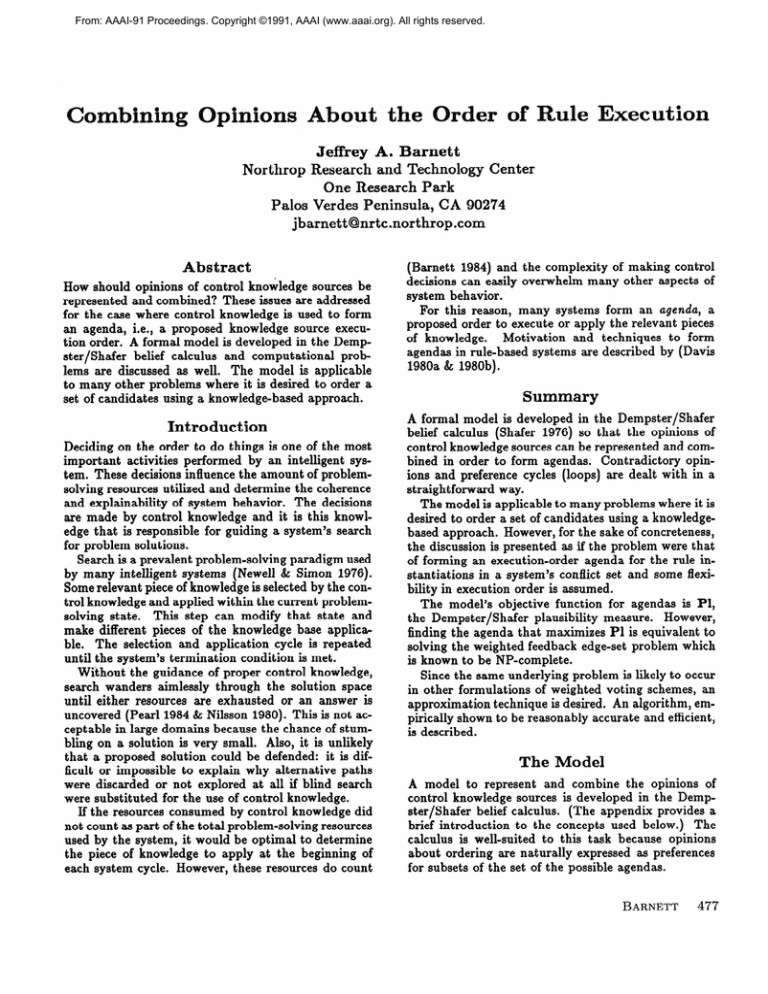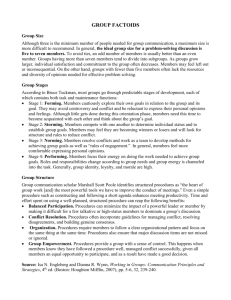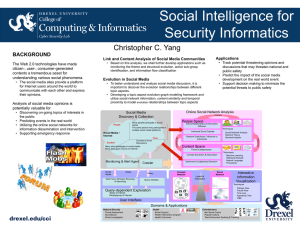
From: AAAI-91 Proceedings. Copyright ©1991, AAAI (www.aaai.org). All rights reserved.
e
t
king
ecution
Jeffrey A. Barnett
Northrop Research and Technology Center
One Research Park
Palos Verdes Peninsula, CA 90274
jbarnett@nrtc.northrop.com
Abstract
How should opinions of control knowledge sources be
represented and combined? These issues are addressed
for the case where control knowledge is used to form
an agenda, i.e., a proposed knowledge source execution order. A formal model is developed in the Dempster/Shafer belief calculus and computational problems are discussed as well. The model is applicable
to many other problems where it is desired to order a
set of candidates using a knowledge-based approach.
Introduction
Deciding on the order to do things is one of the most
important activities performed by an intelligent system. These decisions influence the amount of problemsolving resources utilized and determine the coherence
and explainability of system behavior. The decisions
are made by control knowledge and it is this knowledge that is responsible for guiding a system’s search
for problem solutions.
Search is a prevalent problem-solving paradigm used
by many intelligent systems (Newell & Simon 1976).
Some relevant piece of knowledge is selected by the control knowledge and applied within the current problemsolving state. This step can modify that state and
make different pieces of the knowledge base applicable. The selection and application cycle is repeated
until the system’s termination condition is met.
Without the guidance of proper control knowledge,
search wanders aimlessly through the solution space
until either resources are exhausted or an answer is
uncovered (Pearl 1984 & Nilsson 1980). This is not acceptable in large domains because the chance of stumbling on a solution is very small. Also, it is unlikely
that a proposed solution could be defended: it is difficult or impossible to explain why alternative paths
were discarded or not explored at all if blind search
were substituted for the use of control knowledge.
If the resources consumed by control knowledge did
not count as part of the total problem-solving resources
used by the system, it would be optimal to determine
the piece of knowledge to apply at the beginning of
each system cycle. However, these resources do count
(Barnett 1984) and the complexity of making control
decisions can easily overwhelm many other aspects of
system behavior.
For this reason, many systems form an agenda, a
proposed order to execute or apply the relevant pieces
Motivation and techniques to form
of knowledge.
agendas in rule-based systems are described by (Davis
1980a & 1980b).
Summary
A formal model is developed in the Dempster/Shafer
belief calculus (Shafer 1976) so that the opinions of
control knowledge sources can be represented and combined in order to form agendas. Contradictory opinions and preference cycles (loops) are dealt with in a
straightforward way.
The model is applicable to many problems where it is
desired to order a set of candidates using a knowledgebased approach. However, for the sake of concreteness,
the discussion is presented as if the problem were that
of forming an execution-order agenda for the rule instantiations in a system’s conflict set and some flexibility in execution order is assumed.
The model’s objective function for agendas is Pl,
the Dempster/Shafer plausibility measure. However,
finding the agenda that maximizes Pl is equivalent to
solving the weighted feedback edge-set problem which
is known to be NP-complete.
Since the same underlying problem is likely to occur
in other formulations of weighted voting schemes, an
approximation technique is desired. An algorithm, empirically shown to be reasonably accurate and efficient,
is described.
The Model
A model to represent and combine the opinions of
control knowledge sources is developed in the Dempster/Shafer belief calculus. (The appendix provides a
brief introduction to the concepts used below.) The
calculus is well-suited to this task because opinions
about ordering are naturally expressed as preferences
for subsets of the set of the possible agendas.
BARNETT
477
In the model, primitive opinions are weighted preferences on the execution order of pairs of rule instances.
These pairwise preferences are represented by simple
support functions. Complex opinions are expressed as
sets of primitive opinions and combined with Dempster’s rule.
Representing Opinions
Let R = (q . . . r,} be the collection of rules selected by
the retrieval and filtering mechanism of an expert system. Define 8 as the set of possible execution agendas,
i.e., the set of permutations of R. Thus, if R = {a b c),
then 0 = {abc acb bat bca cab cba} and the problem
of picking an agenda for R is to select the best A E 8.
Therefore, opinions about ordering R are preferences
for particular elements or subsets of 8 because these
elements and subsets encode order relations among the
elements of R.
In the proposed model, a primitive opinion about
the best ordering of R is a pairwise preference written
as u -+ b[w], where a and b are elements of R. This is
an opinion that a should execute before b and w E [O, l]
is the strength of that preference.
A primitive opinion is represented by a simple sup
port function.
The degree of support is w and the
focus is the subset of 0 for which the pairwise preference holds. For example, if R = {u b c}, the opinion
a -+ b[w] is represented by a simple support function
with focus (abc acb cab}.
N.B., the opinion “opposite” to a + b[w] is b + u[w].
Unlike certainty factors (Shortliffe 1976), negative degrees of support are not used; rather, support is focused on complementary propositions.
It is easy to imagine other kinds of primitive opinions
than those representable in this model, i.e., opinions
that support subsets of 8 not allowed herein. However,
as shown below, sets of pairwise preferences adequately
capture the intent of many types of opinions expressed
by control knowledge.
Combining Opinions
The Dempster/Shafer belief calculus provides Dempster’s rule to combine sets of belief functions into a
single belief function. In particular, the opinions of
control knowledge sources are combined by this rule
because primitive opinions are represented by simple
support functions, a specific kind of belief function.
The Best Agenda
The Dempster/Shafer belief calculus provides decision
makers with the Be1 and Pl functions. This section
shows that maximizing PI is the better criterion to
select the best agenda because PI is more reliable than
Be1 in discriminating among alternatives.
Assume that the total set of primitive opinions expressed by the control knowledge sources is represented
by ui + ui[wi], where 1 5 i 2 m. Let z E 8 be an
agenda and define ui(z) to be satisfied if and only if z
478
BELIEF FUNCTIONS
is compatible with u. ---*vi wi i.e., if w appears before
ui in A- Then Pl is;ompdtei
by
PI(z)
=
K
n
(1)
(l- Wi),
-Vi(r)
where K is strictly positive and independent of z
Thus, PI(r) # 0 unless there
(see the appendix).
However, the necesis a w + ui[l], where -ai(
sary and sufficient condition that Bel(z) # 0, where
z = rr . . . rk, ia much stronger:
1. A primitive opinion, ri 4 ri+i[wi],
exists for each 1 5 i < k.
where
wi
#
0,
2. No primitive opinion of the form ri + rj [ 1] exists for
any12 j<ilk.
Therefore, unless the set of primitive opinions is relatively large, Be1 will be zero for most or all of the
z E 8. In fact, if there is a r E R such that no primitive opinion references r, then Be1 will be zero for
every agenda.
Hence, the best agenda is defined, by this model, to
be the z E 8 that maximizes Pi(z) because Pl is more
stable and reliable at discriminating agenda merit than
is Bel.
Complex Opinions
The opinions of control knowledge sources are often
derived from general knowledge and knowledge of the
application rather than specific knowledge about particular rules (Davis 1980a & 1980b). For example, a
typical control rule in an investment domain is,
If the economy is fluctuating, prefer the rules that
analyze risk.
This control rule is interpreted to prefer to execute
investment rules that analyze risk before those that do
not given that the system has (can) deduce that the
economy is fluctuating. Another example of a control
rule in the same domain is,
If bonds are being considered, prefer the rules that
recommend investments with higher Standard and
Poor5 ratings.
This example references a ranking (the Standard and
Poors index) and groups some of the investment rules
(those that recommend bonds) so that the groups can
inherit the ranking. Then it prefers to execute the rules
so ranked in the specified order.
Both examples exhibit execution-order preferences
that induce partial orders on R, the domain rules. A
simple representation captures the intent of such control knowledge.
Let the Pi, where 1 5 i 5 m, be predicates with
domain R and assume that the weights sij E [0, l]
are given. The partial order preference is realized
as the collection of all primitive opinions of the form
Q -+ b[eij], where U, b E R, Pi(a), Pi(b), and i < j.
Thus, the control knowledge source is represented by
d
Figure 1: Example with 3 interpretations.
its Pi and sij. It should be noted that the Pi may need
to access variables in the problem-solving state of the
expert system, e.g., “economy fluctuation” in the first
example in this section.
The next section presents an example and considers
alternative realizations of the execution-order preferences of control knowledge sources.
Alteqnative Interpretations
Let R = {cc b c} and assume that a control knowledge
source prefers that execution be in alphabetically order. In the notation of the previous section, a, b, and c
are the only rules that, respectively, satisfy PI, PQ, and
P3. Additionally, let s& = sac = s& = s. Thus, the
opinion of this control knowledge source is expressed
by a + b[s], a -+ c[s], and b + c[s].
With these assumptions, Figure 1 shows the value of
Pl for each z E 9. The column labeled “Model” lists
the Pl values computed by the model. The six z E 0
split into four groups because Pl awards values that
depend on whether z agrees with 0, 1, 2, or 3 of the
primitive opinions.
An alternative realization of the complex opinion
that a, b, and c should execute in the stated order is to
combine only the two primitive opinions a 3 b[s] and
b -+ c[s], i.e., do not take the closure of the transitive
preference relation. This alternative results in the Pl
values shown in the figure under the heading “Simple”.
A third alternative is to form a single simple support
function that focuses only on the singleton set (abc).
The PI values that result are shown in the column
titled “Chunk”.
A problem with the second and third interpretations
is that they are less discriminating then the model’s.
The third alternative is the most insensitive: minor disagreements such as acb, with only b and c out of order,
are awarded the same Pl value as total disagreements
such as cba where everything is backwards.
Since there can, in general, be many knowledge
sources expressing ordering opinions, it is not a good
idea to employ an all-or-nothing interpretation in domains where “half a loaf is better than nothing”. The
approximation computation described below is applicable with both the &Model” and the “Simple” interpretations but not “Chunk” because the latter is not
based on pairwise preferences.
Figure 2: Example with a loop.
ptimization
agenda means fi
l(z). This is shown to be the weighted
feedback edge-set problem which is known to be NPcomplete (Carey & Johnson 1979).
Since K in Equation 1 is strictly positive, simple
algebra demonstrates that the llrE 0 that minimizes
l+r) = c w;,
(2)
loi
is the best agenda, i.e., the z E 8 that maximizes
in Equation 1. The wi = - log(1 - wi) are the weights
of evidence, in the terminology of (Shafer 1976), and
are positive because wi E [0, l]. Hence, PI’(R) is just
a sum of a positive weight for each ui + ui [wi] that is
not compatible with ?r.
One would expect a similar formulation, with perhaps different weight semantics, for any weighted preference scheme used to determine optimal agendasthose that are incompatible with the least vote weight
are valued most.
An example is shown graphically in Figure 2. The
elements of-R are the nodes-and each directed labeled
arc represents a pairwise preference, e.g., the arc labeled w:b directed from a to b represents a + b[wab].
Thus, the example shows five primitive opinions that
contain a preference loop between a, b, and c formed
by the arcs labeled &,) w:,, and wicr.
Let z = abed, then PI’(z) = wda because the arc
directed from c to a is the only one that is inconsistent
with ?r. Since there is a cycle,-every z E 0 is penalized
bY a weight on at least one of the arcs in that cycle.
In the general case, every agenda is penalized by
the weight of at least one arc in each directed cycle
in the preference graph. Therefore, the best agendas
are those that are compatible with the graph that remains after the least total weight has been removed
on a set of arcs that cut each directed cycle. Finding
a minimum-weight deletion is the weighted feedback
edge-set problem.
Again, consider the example with a loop shown in
Figure 2. The best you can do is to accept one of the
penalties, Wbb, wLc, or w:~. Assume that the minimum
of the three is whbs Then the orders bead and bcda both
have this minimum penalty and, hence, both maximize
plausibility, i.e., both are optimal.
BARNETT
479
PROCEDURE
1.
2.
3.
FIND-AGENDA(d)
Set s to a random permutation of R.
Visit the elements of I in left-to-right
order. Move each visited element to the
position in ‘lr that minimizes Pi’(n). If
any element is moved by this step, continue with the next step. Otherwise,
halt and return IF.
Visit the elements of A in right-to-left
order. Move each visited element to the
position in a that minimizes PI’(n). If
any element is moved by this step, continue with the previous step. Otherwise, halt and return z.
END FIND-GOOD-AGENDA;
Figure 3: Minimization algorithm.
A graphical representation of a set of primitive opinions provides a simple method to check their consistency. Let R be the graph’s nodes as above. However, only include those edges that represent primitive
opinions of the form a + b[l]. The total set of control knowledge opinions is consistent if and only if this
restricted graph is free of directed cycles.
An Approximation
Since determining the f E 0 that minimizes Equac
tion 2 is an NP-complete problem, an approximation
technique is necessary if the above model is to be used
for applications with more than a few agenda items.
Unfortunately, a search for previous work on such approximations has not been fruitful.
Therefore, several simple approximation techniques
were programmed and empirically tested, by comparison to each other, and to actual optimal results for
small problems. The test cases were generated randomly and exact values computed, when possible, by
exhaustive search.
Based on the empirical evidence, one algorithm appears to be efficient and accurate enough to be useful.
The core of that approximation is shown in Figure 3.
Given the n x n matrix, w’, it is possible to find and
move an element to its optimal place, relative to the
current order of r, in O(n) time, where n = R . Thus,
each application of step 2 and step 3 is O(n !2). ’
Steps 2 and 3 alternate because it is usually possible
to prune a substantial part of a step 3 after a step 2
and vice versa. On the other hand, if either step is
directly repeated, pruning is not available.
Empirical testing, with n varying from 3 to 100,
showed that the entire algorithm is O(nZ), where z
is between 2.6 and 3. Several cases were tested with
n = 200 and the results were compatible with this
analysis. Exponent variation does not appear to depend very much on n or on the average degree of the
preference graph. Rather, it is most strongly affected
480
BELIEF FUNCTIONS
by the fraction of the total arcs that agree with the
best agendas.
This algorithm is a local optimizations that employs
a random starting point. Since different starting points
can find different local optima, it may pay to run the
algorithm several times and keep the best solution.
Empirical evidence suggests that the need for multiple applications increases when a relatively large fraction of the wij are zero, the distribution of non-zero
wij values is flat, and therefore, the variance between
different solutions tends to be largest. The variance in
PI’ for different starting points was never observed to
be more than a few percent.
Replanning
Sometimes new information becomes available while an
execution agenda is being pursued. That raises questions about how to test the impact on the unexecuted
part of the current agenda and how to economically
reorder that portion if and when it seems appropriate
to do so.
The algorithm described in the previous section has
a property that makes it well-suited to address such
replanning problems: every subagenda (a contiguous
sequence) in K is a local optimum in the sense that
it cannot be improved by moving any single element
within that subagenda. In particular, the unexecuted
portion of X, a tail sequence, is a local optimum unless
some W:j changes, where both ri and rj are in the tail
of z.
If a change in opinions affecting rules that have not
been executed occurs, a modification of the algorithm
shown in Figure 3 is used. The changes are to restrict
w’ to the tail and not execute step 1. In other words,
start with an agenda that is probably close to reasonable rather than start from a random point.
The full algorithm with multiple starting points only
needs to be considered if there is substantial change
in the value of Pl’ calculated for the tail. Empirical
testing shows that this type of replanning, where only
a few opinions change, is very economical. Typically,
steps 2 and 3 do not iterative-one
or two applications
are sufficient.
It is possible to add new candidates to the tail of z
or remove some that no longer belong in the conflict
set. In these cases, simply place the new candidates
grow and/or restrict
at the end of z, appropriately
w’ to reflect the actual
slate of candidates
in the tail,
and rerun the algorithm using the modified 7~as the
starting point.
In all of these cases, the approximation algorithm
commends itself as a diagnostic to determine the probable impact of the changed opinions. In addition, it can
do the full replanning when it is appropriate to do so.
The fact that subagendas of locally optimal agendas
are themselves locally optimal, provides a measure of
stability.
iscussion
combination to be m(B) = 0 and
The model developed here appears to have sufficient
generality to solve ordering problems in many domains.
Its use of the Dempster/Shafer belief calculus makes
the formulation straightforward because (1) it is desired to invest belief in subsets of the possible agendas
and (2) the simple support functions provided by the
calculus make it easy to do so.
Finding the best agenda, as defined above, is an NPcomplete problem. However, the availability of a reasonably efficient and accurate approximation partially
mitigates this fact. Further, the underlying cornput*
tion just determines the agenda that is incompatible
with the least vote weight, an idea that seems to be
very natural.
Acknowledgements
Thanks to Dan Geiger and the referees for many valuable comments that improved this paper.
Appendix:
This is a brief introduction to the Dempster/Shafer
Belief Calculus. The interested reader is referred to
(Shafer 1976) f or more detailed explanations of the
concepts that are involved.
Let Q be a set of mutually exclusive and exhaustive
possibilities and interpret the subsets of 0 as disjunctions of their elements. The function, m : 2e ---) [0, 11,
is called a basic probability assignment or mass function if m(8) = 0 and
C m(S)
SC0
=
=
x
=
m(T)
K X
C
sln...ns,=S
K-1
=
m(S;)
l<iln
m(Si),
for nonempty S C 8. This combination is defined
whenever K is.
A sample support junction is a belief function for
which there is at most one S # 8 such that m(S) # 0.
The trivial simple support function is the one where
m(Q) = 1 and m(S) = 0 for all S # 0.
Other simple support functions are parameterized
and a w E (0, l], where m(F) = 20 and
byaFc
m(Q) = 1 - 20. The subset F is called the focus of the
simple support function and w is called its degree of
support.
A simple support function is a mechanism to place
committed belief on the single hypothesis represented
by its focus. The remaining weight, placed directly on
0, is uncommitted since 0 represents the universally
true proposition.
Let Dempster’s rule be used to combine the ‘~1simple support functions with the foci Fi and degrees of
support si. Then (Barnett 1991) shows that
Pi(a) =
Kx
l<i<n
7FeFi
for the combined belief function. This formula is the
justification for Equation 1 above.
-1.
In the Dempster/Shafer belief calculus, m plays a role
similar to a density function in ordinary probability
theory. The difference is that the domain is 29, the
subsets of @, rather than its elements.
The belief function, Be1 : 2* + [0, I], and the plausibility function, Pl : 2* ---) [0, 11, are defined to play
roles similar to distribution functions.
Bel(S)
m(S)
eferences
Barnett, J.A. 1991. Calculating Dempster-Shafer Plausibility. IEEE Trans. PAMI. In Press.
Barnett, J.A. 1984. How much is control knowledge
worth: A primitive example. Artificial Intelligence 22:77-89.
Davis, R. 1980a. Me&rules: reasoning about control.
Artificial Intelligence 15: 179-222.
Davis, R. 1980b. Content reference: reasoning about
rules. Artificial Intelligence 15:223-239.
Garey, MB., and Johnson, D.S. 1979. Computers and
Intractability. Freeman Press.
Newell, A., and Simon, H.A. 1976. Computer science
as empirical inquiry: symbols and search. CACM
19(3):113-126.
Thus, Bel(S) 5 PI(S) for all S E 8 and, therefore,
BeI and PI are sometimes referred to, respectively, as
the lower and upper probabddy measures. Both are
available to decision makers.
The calculus provides Dempster’s rule to combine
several belief functions into one. Let 9711. . . m, be the
mass functions associated with n belief functions, then
Dempster’s rule defines, m, the mass function for their
Nilsson, N.J. 1980. Principals of Artificial Intelligence.
Tioga Press.
Pearl, J. 1984. Heuristics.
Addison Wesely.
Shafer, G. 1976. A Mathematical
Theory of Evidence.
Princeton University Press.
Shortliffe, E.H. 1976. Computer-Based
sultations:
MYCIN.
Medical Con-
Elsevier.
BARNETT
481




